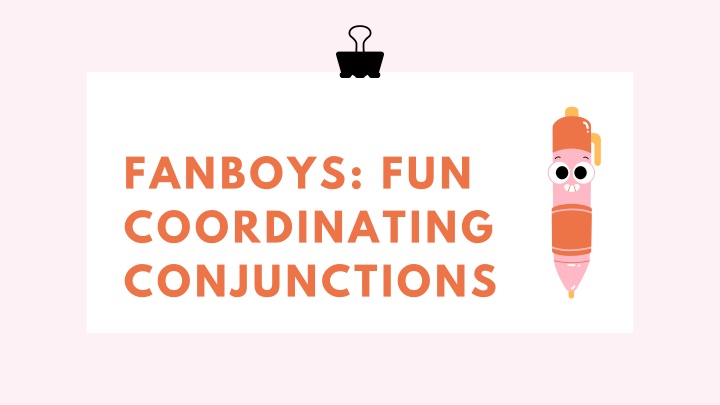
Mastering Coordinating Conjunctions with FANBOYS Fun
Explore the world of coordinating conjunctions with the FANBOYS method, learning how these words help connect ideas in writing and speech. Meet the seven coordinating conjunctions - For, And, Nor, But, Or, Yet, So - and discover how each one functions through engaging examples and explanations.
Download Presentation

Please find below an Image/Link to download the presentation.
The content on the website is provided AS IS for your information and personal use only. It may not be sold, licensed, or shared on other websites without obtaining consent from the author. If you encounter any issues during the download, it is possible that the publisher has removed the file from their server.
You are allowed to download the files provided on this website for personal or commercial use, subject to the condition that they are used lawfully. All files are the property of their respective owners.
The content on the website is provided AS IS for your information and personal use only. It may not be sold, licensed, or shared on other websites without obtaining consent from the author.
E N D
Presentation Transcript
FANBOYS: FUN COORDINATING CONJUNCTIONS
INTRODUCTION What are Coordinating Conjunctions? Coordinating conjunctions are words that connect words, phrases, or sentences. They help us join ideas together in our writing and speaking.
MEET THE FANBOYS FANBOYS is a fun way to remember the seven coordinating conjunctions: F: For A: And N: Nor B: But O: Or Y: Yet S: So
F F is for "For" We use "for" to explain a reason or purpose. Example: I went to bed early, for I was very tired.
A We use "and" to add one idea to another. Example: I like pizza, and I also enjoy pasta.
N N is for "Nor" We use "nor" to present another option when talking about things we don't like or don't do. Example: She does not like chocolate, nor does she enjoy vanilla.
B B is for "But" We use "but" to show the difference between two ideas. Example: I wanted to go for a walk, but it started to rain.
O We use "or" to give a choice between options. Example: Would you like tea or coffee for breakfast?
Y We use "yet" to talk about something surprising or unexpected. Example: He studied hard, yet he did not pass the exam.
S S is for "So" We use "so" to show what happens because of something else. Example: It was raining, so we decided to stay indoors.
